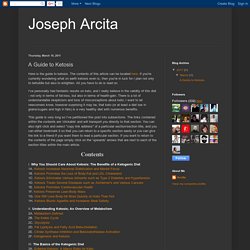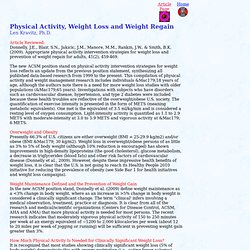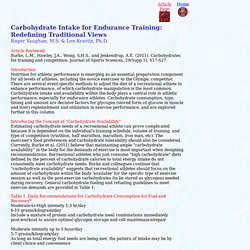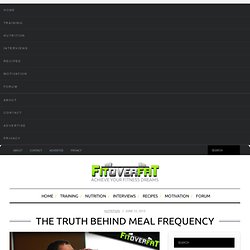

Wheat Belly? Wheat BERRY! How To Guide: Carb Cycling Made Easy. Carb Cycling is a low/no-carbohydrate diet with intermittent periods of high or moderate carbohydrate consumption; essentially you are cycling your carbs to achieve a desired result.

Most people have the misconception that consuming low carbs on a day to day basis for long periods of time is good for them. The main problem with low-carb diets is that they are meant as temporary diets; they deplete your energy and strength and are not the best method when attempting to lose body fat and retain muscle. You cannot eat that way forever.
A Guide to Ketosis. Here is the guide to ketosis.

The contents of this article can be located here. If you're currently wondering what on earth ketosis even is, then you're in luck for I plan not only to befuddle but also to enlighten. All you have to do is read on. I've personally had fantastic results on keto, and I really believe in the validity of this diet - not only in terms of fat-loss, but also in terms of health-gain. There is a lot of understandable skepticism and tons of misconceptions about keto; I want to let newcomers know, however surprising it may be, that keto (or at least a diet low in grains/sugars and high in fats) is a very healthy diet with numerous benefits.
This guide is very long so I've partitioned this post into subsections. Increased protein intake and meal frequency reduces abdominal fat during energy balance and energy deficit - Arciero - 2013 - Obesity. Physical Activity, Weight Loss and Weight Regain. Physical Activity, Weight Loss and Weight Regain Len Kravitz, Ph.D.

Article Reviewed: Donnelly, J.E., Blair, S.N., Jakicic, J.M., Manore, M.M., Rankin, J.W., & Smith, B.K. (2009). Appropriate physical activity intervention strategies for weight loss and prevention of weight regain for adults, 41(2), 459-469. The new ACSM position stand on physical activity intervention strategies for weight loss reflects an update from the previous position statement, synthesizing all published data-based research from 1999 to the present. This compilation of physical activity and weight management research includes individuals &Mac179;18 years of age, although the authors note there is a need for more weight loss studies with older populations (&Mac179;65 years). Investigations with subjects who have disorders such as cardiovascular disease, hypertension, and type 2 diabetes were included because these health troubles are reflective of the overweight/obese U.S. society.
Carbohydrate Intake. Burke, L.M., Hawley, J.A., Wong, S.H.S., and Jenkendrup, A.E. (2011).

Carbohydrates for training and competition. Journal of Sports Sciences, 29(Supp 1), S17-S27. Introduction Nutrition for athletic performance is emerging as an essential preparation component for all levels of athletes, including the novice exerciser to the Olympic competitor. There are several event-specific methods to adjust the diet of a recreational athlete to enhance performance, of which carbohydrate manipulation is the most common. Carbohydrate intake and availability within the body plays a central role in athletic performance, especially for endurance athletes. Table 1. Moderate intensity up to 1 hour/day 5-7 grams/kilogram/day As long as total energy fuel needs are being met, the pattern of intake may be by client choice and convenience Atkinson, F.S., Foster-Powell, K., Brand-Miller, J.C. (2008). The Truth Behind Meal Frequency. Introduction Meal frequency is a much debated topic in the fitness and nutrition industries which started about 60 years ago and still continues to this day.

Gyms worldwide echo with the sounds of trainees arguing over how many meals to eat in order to obtain maximum results! Have you ever heard that eating 6 meals a day speeds up your metabolism? Or that your body can only absorb a certain amount of protein in a single meal? Perhaps you’re more familiar with the story of how eating every 2-3 hours stops your body going into a catabolic state thus preserving all of your hard earned muscle? BMR Calculator. Adult Energy Needs and BMI Calculator - USDA/ARS Children's Nutrition Research Center. How many calories do adults need?

Knowing your body's daily calorie needs can be an important first step in adopting a realistic diet and physical activity plan that can help you attain and maintain a healthy weight. How to interpret your BMI Healthy weight: Under 25 Overweight: 25 to 29.9 Obese: 30 or more Based on the National Academy of Sciences 2002 Energy Recommendations for Adults.
Between 20 to 50 percent of your daily caloric needs are determined by physical activity. "It's easier to get up the will-power to turn down a 900 calorie double-burger with cheese and sauce and opt for a 400 calorie chicken sandwich or salad when you know your entire daily needs are about 1600 calories," says Joan Carter, a CNRC registered dietitian and instructor of pediatrics at Baylor College of Medicine in Houston.